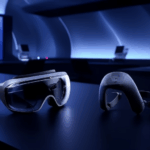“`html
From Smartwatches to Health Trackers: Exploring the Versatility of Wearable Technology
Introduction
Wearable technology has become an integral part of modern life, seamlessly blending convenience with innovation. These devices, ranging from smartwatches to health trackers, offer users a range of functionalities that enhance their daily experiences. The increasing popularity of wearables is driven by their ability to integrate seamlessly into our routines, providing real-time feedback and assistance. This article delves into the versatility of wearable devices, focusing on smartwatches and health trackers, and explores how they are transforming various aspects of our lives.
Evolution of Wearable Technology
The journey of wearable technology began with simple pedometers and has since evolved into sophisticated devices capable of performing multiple tasks. Early prototypes were primarily focused on fitness tracking, but as technology advanced, so did the capabilities of these devices. Key milestones include the introduction of Bluetooth connectivity, which allowed for seamless integration with smartphones, and the development of more advanced sensors for health monitoring. Today, wearables come in various forms, each offering unique features tailored to specific needs.
One of the most significant innovations in recent years has been the miniaturization of components, allowing for sleeker designs while maintaining robust performance. This evolution has been crucial in making wearables more appealing to consumers, who now expect stylish and functional devices. As we look back at the history of wearables, it’s clear that continuous innovation has played a pivotal role in shaping the industry.
Smartwatches – A Multifunctional Companion
Smartwatches are perhaps the most versatile type of wearable device, offering a wide array of functionalities that go beyond mere timekeeping. At their core, smartwatches serve as extensions of smartphones, providing notifications, call alerts, and access to a variety of apps. This integration allows users to stay connected without constantly reaching for their phones, enhancing productivity and convenience.
In addition to basic smartphone features, many smartwatches now include advanced functionalities such as GPS, fitness tracking, and even contactless payment capabilities. These features make them ideal companions for both casual users and professionals alike. Popular brands like Apple, Samsung, and Fitbit have led the market with innovative designs and cutting-edge technology. For instance, the Apple Watch Series 7 boasts a Retina display, fast charging, and enhanced water resistance, while the Samsung Galaxy Watch 4 offers a robust health monitoring suite and improved battery life.
Health Trackers – Monitoring Your Well-being
Health trackers are designed specifically to monitor various aspects of one’s health and well-being. These devices range from simple fitness bands to sophisticated heart rate monitors, each offering unique insights into personal health metrics. One of the primary benefits of health trackers is their ability to provide real-time data, enabling users to make informed decisions about their lifestyle.
Fitness bands, for example, typically track steps, calories burned, and distance traveled, while more advanced devices can monitor heart rate, sleep patterns, and even blood oxygen levels. This data can be invaluable for individuals looking to improve their overall health, as it allows them to set goals, track progress, and adjust their routines accordingly. Additionally, some health trackers offer personalized wellness plans based on the collected data, helping users achieve their fitness and health objectives more effectively.
Versatility Across Different Use Cases
Wearable technology is not limited to personal use; it also plays a significant role in various industries, including fitness, healthcare, and fashion. In the fitness sector, wearables are used by athletes and fitness enthusiasts to track performance and optimize training regimens. In healthcare, these devices are increasingly being adopted for remote patient monitoring, allowing doctors to keep tabs on patients’ health metrics without requiring in-person visits.
Moreover, wearable technology is finding its place in the fashion industry, where stylish and functional accessories are gaining popularity. Companies like Garmin and Huawei have successfully merged fashion with functionality, creating products that appeal to a broader audience. Looking ahead, the potential applications of wearables are vast, from assistive technologies for people with disabilities to augmented reality glasses that enhance user experiences.
Challenges and Considerations
Despite the numerous benefits of wearable technology, there are several challenges that must be addressed. Privacy concerns and data security are among the most pressing issues, as wearables collect sensitive information about users. Ensuring that this data is protected from unauthorized access is critical to building trust with consumers. Additionally, battery life remains a limitation for many devices, necessitating frequent recharging, which can be inconvenient for users.
Compatibility issues with different operating systems and devices also pose challenges. Not all wearables work seamlessly with every smartphone or computer, which can limit their utility for some users. Addressing these challenges will be essential for the continued growth and adoption of wearable technology.
Conclusion
In conclusion, wearable technology has come a long way since its inception, offering users a wide range of functionalities that enhance their daily lives. From smartwatches to health trackers, these devices are transforming the way we interact with technology and manage our health. As the industry continues to evolve, we can expect even more advanced features and applications, further solidifying the role of wearables in modern society.
The future of wearable technology looks promising, with ongoing innovations poised to address current challenges and expand the possibilities for users. Whether it’s through improved privacy measures, longer battery life, or enhanced compatibility, the next generation of wearables promises to deliver even greater value and convenience. As we move forward, it’s clear that wearable technology will continue to play a vital role in shaping our lives.
“`

